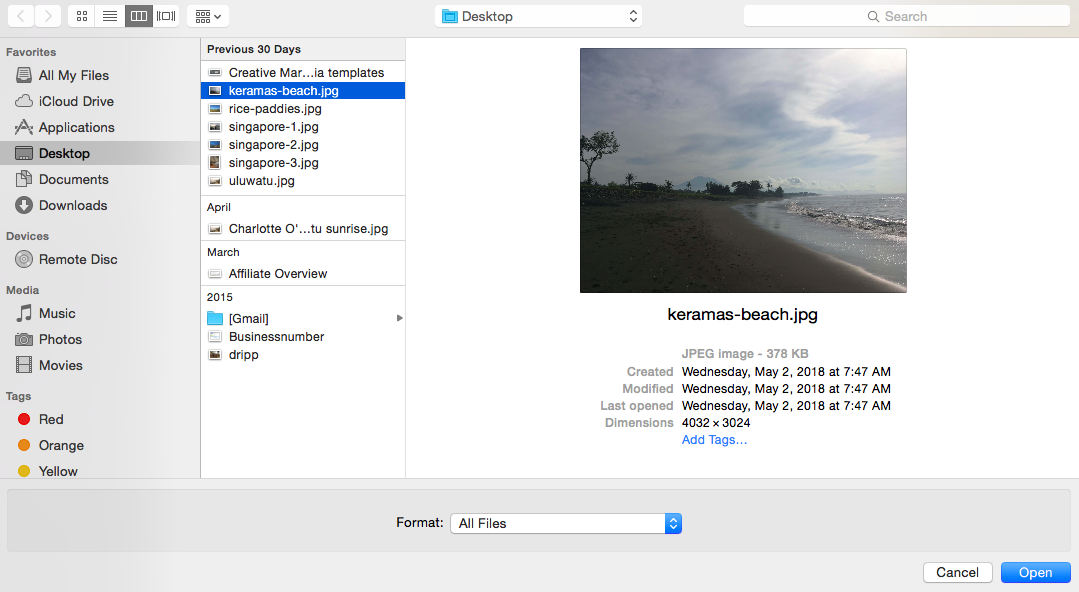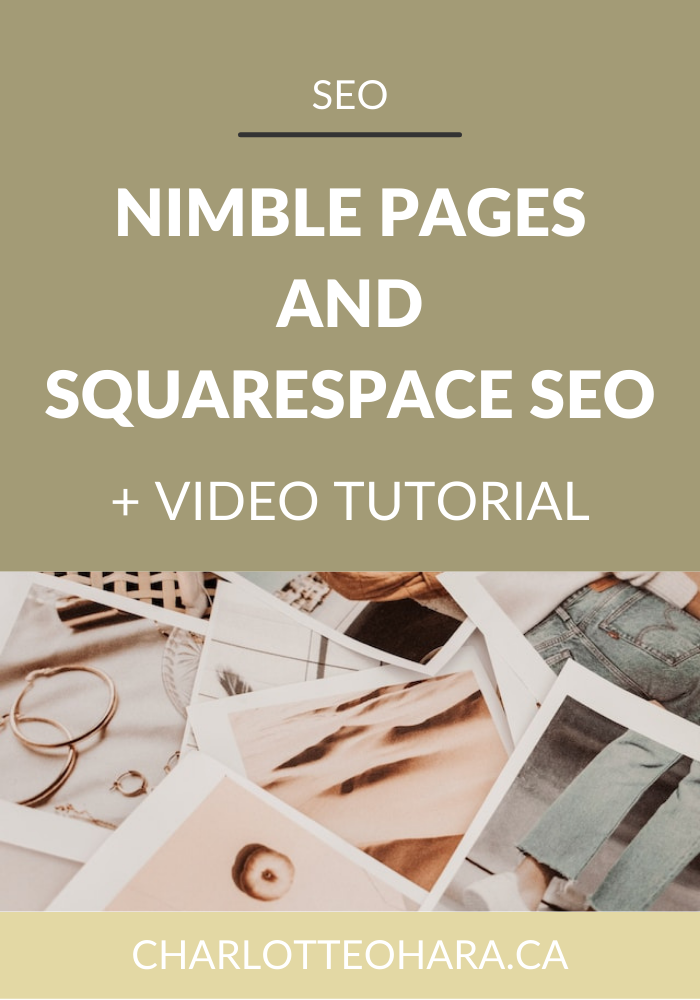How to get images on your Squarespace website to show up in Google image search results
How to get Squarespace website images to show up in Google image search results
There's no denying it, Google is everyone's favourite search engine. It's where we turn everyday to find the answers to our most burning questions, look something up on the fly, or help us get the information we're looking for.
It's one thing to use a search engine like Google for your own personal use, but as website owners, we're constantly making sure that our websites are set up in the best way possible to show up in Google's search results. We spend a considerable amount of time and effort on this because we know that ranking higher and showing up in Google's search results will help us grow faster by increasing traffic to our website and exposing our site to a wider audience.
When it comes to Google search results, most people's minds immediately jump to written content, specifically the text of a website. Most of the times, this means webpage and blog post content. This isn't wrong, per se, but it's also not the full picture.
In the same way that Google indexes all the written content on the web and returns it in search results, Google also cares about images - a lot. There's an entire Google Image Search section that looks to index, contextualize and present all the images online whenever someone searches for a particular keyword or term.
Images on a website play a huge part in SEO, and if you add and set up images on your site in a way that has Google Image Search in mind, you'll be way ahead of the competition.
In this post, we are going to look at how to get the images on your Squarespace website to show up in Google image search results. There are so many SEO benefits from this and it's a great thing to focus on if you want to grow your website.
SEO is admittedly confusing so if you have any questions, you are welcome to leave a comment below and I’ll do my best to respond. I personally work with select consulting and strategy clients every month so if you’re interested in that, please get in touch. I also share SEO tips with my newsletter (which you can sign up for here). Check out my Squarespace SEO page for more resources, blog posts & video tutorials and get your copy of my Squarespace SEO Checklist below for free. Phew!
Sit back, relax, and let's take a look!
Related posts about website images:
SQUARESPACE SEO SERIES
This article is part of my series on Squarespace SEO. I have so many tips to share on the subject that it would have been crazy to put it all in one article! There are many misconceptions about Squarespace SEO which is why I've dedicate so many posts to this topic. Enjoy!
Click to view all posts in the Squarespace SEO Series
Visit my Squarespace SEO page for lots more resources.
What is Google Image Search?
Google Images is a search service owned by Google that allows users to search the Web for image content. Google Image Search can be an extremely powerful way to drive traffic to your website, if you know how to set yourself up for success. When someone does a search, Google will return a bunch of links to relevant web content (read: text) but will also display images related to the search terms.
For example, if you search "Macbook Air", Google will return Apple's website as well as photos of various Macbook Airs. Text AND image show up in search results.
Returning images in Google search results seems like a no-brainer but it's not exactly the easiest thing to do, from a technical standpoint.
Believe it or not, Google (and other search engines) can't actually see images, photographs or graphics on a website. Instead, Google Images uses the context of those images to determine an image's relevance to a search result.
This means that in order for Google to understand what an image depicts, the image's contextual elements must be correctly assigned. If you want to make sure that your website ranks highly in Google Image Search results (who wouldn't?!), keep the tips and tricks below in mind!
1. Name the image file with Google in mind
When preparing images that you will later upload to your website, the first (and most important step!) is to make sure the files are correctly named.
You may be temped to keep the file name as "IMG2287.jpg", for example, but this would be a major disservice since it doesn't tell Google anything about the image. Instead, take a moment to assign a descriptive image file name. Something like "Keramas-Beach.jpg" is a much stronger title because it tells us what the image is about.
You'll be able to see what the image file name is and update/edit it through the "Finder" files overview of your computer - see below for example:
Note : be sure to update the actual image file's name for every image, photo, graphic, whatever that you upload to your Squarespace website so that Google has lots of information to index.
Related: How to name photos for increased SEO in Squarespace (video tutorial)
2. Change the Squarespace Image Filename field
Now that you've named the actual image file, the next order of business is to update the image filename attribution in the Squarespace image settings.
This will tell Google (and other search engines) exactly what the image you're referencing is about. It will also improve the accessibility of your website for the visually impaired and/or those using screen readers. This step can be as simple as describing the image with relevant keywords.
Continuing with the Keramas beach example, the Squarespace filename field will automatically populate as "keramas-beach.jpg" but here's where we can update it to something stronger, like "Sunrise at Keramas Beach Bali".
The goal here is to be descriptive and to outline with detail what the image shows.
This gives Google much more information about the image and thanks to this step, they're able to better understand what the image is about. Now they can add the image to their index and include in in search results for particular keywords accordingly.
This is also useful for readers who are visually impaired since the image alt text will describe what the image shows.
Note: Descriptive filenames can help your image rank in Google Image Searches but it's important not to get carried away with your keywords. Keep in mind that Google will penalize you for keyword stuffing since it considers it spam, and your search result ranking could be negatively affected as a result. Keep it natural!
3. Keep the Images Relevant to the Page Content
Now that we've covered why it's important to name the actual image file's name AND fill out the Squarespace image filename field, I want to stress that it's important to make sure the images you're adding to a page/post are actually relevant.
"Wait, how does this affect Google Image Searches and SEO?" <--- you, probably
Let me tell you why this is! Google will expect to "see" images that make sense given the context of the written text on the page/post, and will reward you with high search result rankings if it all fits together. For example, Google would expect to see an image of a beach on a page that talks about travelling as a digital nomad. However, if I randomly threw the beach pic on my Services page, Google would notice that the image makes zero contextual sense and wouldn't favour my image in future search results.
This is because when someone clicks on the image that shows up in Google Image Searches, odds are they will head over to the page/post that hosts it. If they find that the content of that page has NOTHING to do with the image, the visitor will not find it helpful to them, and Google has essentially failed to deliver a quality search result to that user.
I definitely recommend adding images to your Squarespace website because they do wonders for SEO, but make sure that you're adding them to the page/post for the right reason. It's better to have fewer, relevant images so that Google can include them effectively in their search results.
4. Don't overload the page with basically the same images
Bloggers, this tip is especially for you!
Have you ever tried to find a recipe on a food blogger's site and there's like 40 pictures of the same slice of pizza before you get to the goods, which is the actual recipe? Yet you had to scroll alllllllllllllllllllll the way down to the bottom of the post, past a ridiculous amount of photos to get there? This is overkill and Google doesn't like it!
Many bloggers, especially those who focus on fashion/food/lifestyle/design/etc., will include a LOT of images in a single post. It's not uncommon to see well over a dozen images that are basically the same included in a post, because the content creator is trying to capture different angles, features or other attributes.
This is helpful for giving the visitor lots of shots/angles about whatever content the image features, BUT it isn't the best approach if you have Google and SEO in mind.
For one thing, visitors to your site will not spend all their time looking at these similar images - instead, they are going to scan through them all. If you have too many images and it's hard to get to the meaty text, it could negatively affect your website's bounce rate.
Secondly, loading all these images will take a long because of the larger file size. These precious seconds are time that your audience (and potential customers or clients) don’t necessarily have. Google will also penalize you website for slow loading time, which is another downside.
Best practice is focus on quality over quantity in the images that you include in your Squarespace website, especially if you care about SEO and showing up in Google Image Search results. Choose only the best images to display – I recommend no more than 20 photos (max!!) per gallery for the best results.
Final Thoughts
It's not hard to "cheat the system" and get higher ranking in Google Image Search results. So long as you know what fields to fill out and what settings to follow for the images on your Squarespace website, you'll quickly develop the habits that ensure you show up in search results in no time.
Not only will this increase traffic to your website, it'll also help you to serve your online audience better and make sure that your content is getting in front of the right people.
As you grow your website, it's super important to make sure that you're considering images and the role they play in SEO. Google Image Search is one of the biggest drivers of traffic back to many websites, and you want to get the most out of this amazing feature! The SEO benefits are totally worth it if you want to play big and get more eyes on your Squarespace site.
Remember that SEO will grow and improve over time as you build it up, and search engines won’t expect you to be perfect right from the start. SEO is ever changing and requires constant attention, but it doesn’t have to take hours and hours of your time in order to start seeing real results.
Now it's your turn to tell me, how do the images on your website stack up for SEO? Are you naming your images with Google Image Search in mind? Does this clear up what Google Image Search is and how you can get your content to show up in it's results? Are you committed to getting SEO benefits from the images on your site?
Leave me a note down in the comments below and I’ll do my best to answer them. No matter what type of website you have, it will benefit from SEO so I encourage you to start where you are and work on improving your SEO a little bit every week.
If you want more SEO goodness, be sure to check out my Squarespace SEO page for all resources on the topic.
You can also sign up for my newsletter (right here or below), where I often share Squarespace SEO tips, tricks and high-quality exclusive content. I send out emails to my list every week and while I don’t talk about SEO every time, I can guarantee that you’ll still find the newsletter topics interesting, entertaining and worth your time.
Finally, shameless plug : hit me up with any specific questions you have about Squarespace SEO and your website because I’m your girl. You can reach out to me directly if you’re interested in working together on your website and we can talk about whether or not you would be a good fit for my consulting and ongoing services. I can’t take on every request to do SEO consulting but I do pick a few websites and businesses to work with every month and I’d love for you to be one of them.
You may also be interested in:
Top Squarespace SEO - online course details and enrollment
Squarespace SEO for Affiliate Marketing - masterclass
LAUNCH YOUR BEST SITE - FREE ECOURSE
Interested in learning more about what it takes to get a website up and running? Sign up for my free 7 day e-course!













